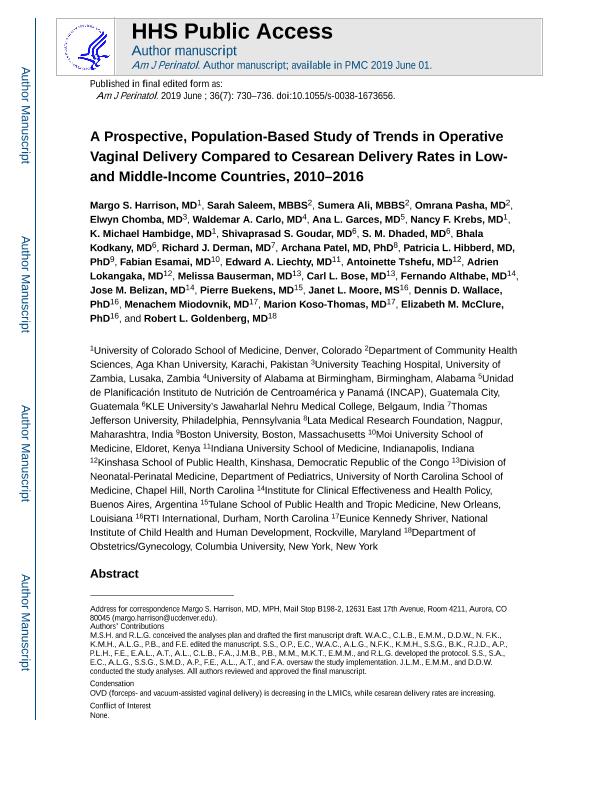Artículo
A Prospective, Population-Based Study of Trends in Operative Vaginal Delivery Compared to Cesarean Delivery Rates in Low- and Middle-Income Countries, 2010-2016
Harrison, Margo S.; Saleem, Sarah; Ali, Sumera; Pasha, Omrana; Chomba, Elwyn; Carlo, Waldemar A.; Garces, Ana L.; Krebs, Nancy F.; Hambidge, K. Michael; Goudar, Shivaprasad S.; Dhaded, S.M.; Kodkany, Bhala; Derman, Richard J.; Patel, Archana; Hibberd, Patricia L.; Esamai, Fabian; Liechty, Edward A.; Tshefu, Antoinette; Lokangaka, Adrien; Bauserman, Melissa; Bose, Carl L.; Althabe, Fernando ; Belizan, Jose
; Belizan, Jose ; Buekens, Pierre; Moore, Janet L.; Wallace, Dennis D.; Miodovnik, Menachem; Koso-Thomas, Marion; McClure, Elizabeth M.; Goldenberg, Robert L.
; Buekens, Pierre; Moore, Janet L.; Wallace, Dennis D.; Miodovnik, Menachem; Koso-Thomas, Marion; McClure, Elizabeth M.; Goldenberg, Robert L.
 ; Belizan, Jose
; Belizan, Jose ; Buekens, Pierre; Moore, Janet L.; Wallace, Dennis D.; Miodovnik, Menachem; Koso-Thomas, Marion; McClure, Elizabeth M.; Goldenberg, Robert L.
; Buekens, Pierre; Moore, Janet L.; Wallace, Dennis D.; Miodovnik, Menachem; Koso-Thomas, Marion; McClure, Elizabeth M.; Goldenberg, Robert L.
Fecha de publicación:
06/2019
Editorial:
Thieme Medical Publ Inc
Revista:
American Journal of Perinatology
ISSN:
0735-1631
Idioma:
Inglés
Tipo de recurso:
Artículo publicado
Clasificación temática:
Resumen
Objective Few data are available on cesarean delivery and operative vaginal delivery trends in low- and middle-income countries. Our objective was to analyze a prospective population-based registry including eight sites in seven low- and middle-income countries to observe trends in operative vaginal delivery versus cesarean delivery rates over time, across sites. Study Design A prospective population-based study, including home and facility births among women enrolled from 2010 to 2016, was performed in communities in Argentina, Democratic Republic of Congo, Guatemala, India, Kenya, Pakistan, and Zambia. Women were enrolled during pregnancy and delivery outcome data were collected. Results We analyzed 354,287 women; 4,119 (1.2%) underwent an operative vaginal delivery and 45,032 (11.2%) delivered by cesarean. Across all sites with data for 7 years, rates of operative vaginal delivery decreased from 1.6 to 0.3%, while cesarean delivery increased from 6.4 to 14.4%. Similar trends were seen when individual country data were analyzed. Operative vaginal delivery rates decreased in both hospitals and clinics, except in the hospital setting at one of the Indian sites. Conclusion In low- and middle-income countries, operative vaginal delivery is becoming less utilized while cesarean delivery is becoming an increasingly common mode of delivery.
Archivos asociados
Licencia
Identificadores
Colecciones
Articulos(CIESP)
Articulos de CENTRO DE INVESTIGACIONES EN EPIDEMIOLOGIA Y SALUD PUBLICA
Articulos de CENTRO DE INVESTIGACIONES EN EPIDEMIOLOGIA Y SALUD PUBLICA
Citación
Harrison, Margo S.; Saleem, Sarah; Ali, Sumera; Pasha, Omrana; Chomba, Elwyn; et al.; A Prospective, Population-Based Study of Trends in Operative Vaginal Delivery Compared to Cesarean Delivery Rates in Low- and Middle-Income Countries, 2010-2016; Thieme Medical Publ Inc; American Journal of Perinatology; 36; 7; 6-2019; 730-736
Compartir
Altmétricas
Items relacionados
Mostrando titulos relacionados por título, autor y tema.
-
Quinteros, Daniela Alejandra ; Ferreira, Luana M.; Schaffazick, Scheila Rezende; Palma, Santiago Daniel ; Allemandi, Daniel Alberto ; Cruz, Letícia (Elsevier, 2016-10)
-
Dasgupta, Indrani; Tanifum, Eric A.; Srivastava, Mayank; Phatak, Sharangdhar S.; Cavasotto, Claudio Norberto ; Analoui, Mostafa; Annapragada, Ananth (Public Library of Science, 2012-01)
-
Cuggino, Julio César ; Ambrosioni, Franco Exequiel ; Picchio, Matías Luis; Nicola, Maribel; Jimenez Kairuz, Alvaro Federico ; Gatti, Gerardo Alberto ; Minari, Roque Javier ; Calderon, Marcelo ; Alvarez Igarzabal, Cecilia Ines ; Gugliotta, Luis Marcelino (Elsevier Science, 2020-07)



